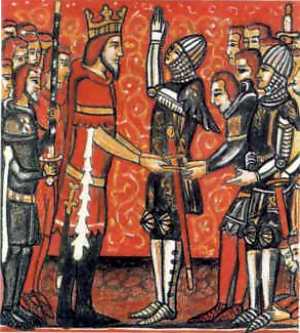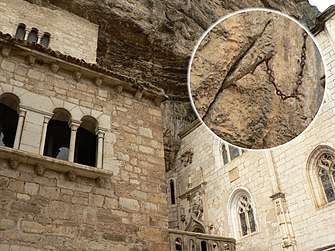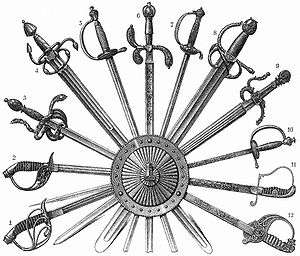Durendal

Durendal or Durandal is the sword of Roland, legendary paladin of Charlemagne in French epic literature. It is also said to have belonged to young Charlemagne at one point, and, passing through Saracen hands, came to be owned by Roland.
The sword has been given various provenances. Several of the works of the Matter of France agree that it was forged by Wayland the Smith, who is commonly cited as a maker of weapons in chivalric romances.[1]
Etymology
The name Durendal arguably begins with a French dur- stem, meaning "hard". Thus Rita Lejeune argued it may break down into "durant dail" meaning "strong scythe".[2][3] Gerhard Rohlfs suggested "dur + ent" or "strong flame".[2][4] The name may also connote the meaning of "enduring".[5]
The Pseudo-Turpin explains that the name "Durenda is interpreted to mean it contains hard strike within" (Durenda interpretatur durum ictum cum ea dans). It has been argued also that the fact that Pseudo-Turpin needed to gloss the name is evidence it was not a name readily understood in French,[lower-alpha 1] hence a foreign name.[6]
One non-French etymology is Edwin B. Place's attempt to construe it in Breton as "diren dall", meaning "blade [that] dulls cutting edge" or "blade blinds".[6] Another is James A. Bellamy's Arabic etymology, explaining the sword's true name to be "Ḏū l-jandal" meaning "master of stone".[7][2][lower-alpha 2]
Chanson de Roland
According to La Chanson de Roland, (The Song of Roland) the sword was brought by an angel to Charlemagne who was at the vale of Moriane, and Charles then gave it to Roland.[8][lower-alpha 3] In that poem, the sword is said to contain within its golden hilt a tooth of Saint Peter, blood of Basil of Caesarea, hair of Saint Denis, and a piece of the raiment of Mary, mother of Jesus, and to be the sharpest sword in all existence.[10][11]
At the Battle of Roncevaux Pass, Roland took the rearguard to hold off the Saracen army troops long enough for Charlemagne's army to retreat into France.[12] Roland slew a vast number of enemies wielding Durendal. With the sword Roland even succeeded in slicing the right arm of the Saracen king Marsile, and decapitated the king's son, Jursaleu, sending the one-hundred-thousand-strong army to flight.[13][14]
Roland later attempted to destroy the sword in battle, to prevent it from being captured by the attacking Saracens. But Durendal proved indestructible.[10] After being mortally wounded, Roland hid it beneath his body as he lay dying along with the oliphant, the horn used to alert Charlemagne[15][16] before succumbing to his injury.
Properties
The sword was capable of cutting through giant boulders of stone with a single strike, and was indestructible.[17]
Previous ownership
Durendal was once captured (but not kept) by the young Charlemagne, according to the 12th-century fragmentary chanson de geste Mainet (the title of which refers to the pseudonym Charles adopted in his youth), when he fled to Spain.[18] Young Charles (Mainés in the text) slays Braimant, obtaining his sword (Durendaus).[19][20] This content is better preserved in some non-chanson de geste texts,[21] and in other language adaptations such as the Franco-Italian Karleto.[22] The place of combat was near the vale of Moriane (Vael Moriale), near Toledo, according to the Low-German version Karl Mainet.[23]
Many years later, the owner of Durendal prior to Roland was a Saracen named Aumon, son of king Agolant,[lower-alpha 4] according to another 12th-century chanson de geste Aspremont. Young Roland, mounted on Naimes's horse Morel without permission,[24] and armed only with a rod, defeated Aumon, conquering the sword as well as the horse Veillantif.[25]
These materials were combined in the Italian prose Aspramonte by Andrea da Barberino in the late 14th to early 15th century. That work stated that after young Carlo (Charlemagne) came in possession of Durindarda (Durendal) by killing Bramante in Spain, Galafro gave it to Galiziella,[lower-alpha 5][26] who then gave it to Almonte the son of Agolante (i.e., French: Aumon).[lower-alpha 6][27][28] Galiziella is glossed as the bastard daughter of Agolante,[29] making her Almonte's half-sister. Durindana is eventually won by Orlandino (young Orlando).[30]
Andrea da Barberino was a major source for later Italian writers. Boiardo's Orlando innamorato traces the sword's origin to Hector of Troy; it belonged for a while to Amazonian queen Pantasilea, and was passed down to Almonte, before Orlando gained possession of it.[31] Ludovico Ariosto's Orlando Furioso follows Boiardo, saying it once belonged to Hector of Troy, but that it was given to Roland by Malagigi (Maugris).

-p140.png)
Tradition has it that when Roland cut a huge gash in the rocks with one blow, it created Roland's Breach in the Pyrenees in the process.[33]
Legend in Rocamadour, Limousin claims that the true Durendal was deposited in the chapel of Mary there, but it was stolen by Henry Curtmantel in 1183.[32]
Local folklore also claims Durendal still exists, embedded in a cliff wall in Rocamadour. In that version, twelfth-century monks of Rocamadour claim Roland threw the sword rather than hiding it beneath himself creating a crevice "due to its sharpness" in the wall. However, the local tourist office now calls the sword a replica of Durendal.[34]
In popular culture
In the Fire Emblem videogame series, Eliwood, the main character of Fire Emblem: The Blazing Blade, has a signature sword named Durandal. In the game, it is explained that the sword used to belong to his ancestor, who was also named Roland. It is also mentioned in the game Fate/Grand Order, where Durandal takes the form of a spear possessed by Hector rather than a sword. It is also said that it passed into the hands of Roland in the form of a sword at some point.
In Bungie's Marathon Trilogy, one of the major recurring characters is an artificial intelligence named Durandal. In the first game, Durandal is visually represented as a computerized human facsimile, with surrounding machinery emblazoned with the icon of a sword.
In the 13th Book of The Dresden Files, Ghost Story, it is mentioned off hand to be one of the swords wielded by the Knights of the Cross, along with Excalibur and Kusanagi. Using these legendary swords, the Knights fight evil in its many forms. Each of the swords is said to contain a nail from the Crucifixion.
The anime, light novel, and manga series High School DxD, also includes Durandal as a holy sword wielded by Xenovia.
Explanatory notes
- ↑ Like Halteclere or Joyeuse.
- ↑ Encouraged by the fact that there are many Arabic sword names with this prefix, e.g. Ḏū-l-Faqār.
- ↑ The scene of the angel giving the sword to Karl (Charlemagne) is depicted in a manuscript of Der Stricker's Karl der Große.[9]
- ↑ This is actually alluded to in Mainet also: "Quant il occist Yaumont fil le roi Agoulant".[20]
- ↑ Come lo re Galafro.. donò Durindarda a Galiziella "; "..e fu poi di Mainetto, cioè di Carlo; e con spada uccise Carlo lo re Bramante, e chiamavasi Durindarda.. Per questa spada Galiziella col cuore feminile ebbe piatà del re Galafro..", Boni (1951), pp. 12–13, Mattaini (1957), p. 422.
- ↑ "Come Galiziella donò Durindarda a Almonte", Boni (1951), p. 13.
References
- Citations
- ↑ Numismatic and Antiquarian Society of Philadelphia (1902). Proceedings of the Numismatic and Antiquarian Society of Philadelphia. Philadelphia: Numismatic and Antiquarian Society of Philadelphia. p. 65.
- 1 2 3 Wright, Michelle R. (1993). Excalibur, an Arthurian Artifact. Stanford University. p. 254, note 43.
- ↑ Lejeune (1950), p. 158.
- ↑ Rohlfs, Gerhard (1936), "Was bedeutet der Schwertname Durendal?", Archiv für das Studium der neueren Sprachen, CLXIX: 57–64
- ↑ Sayers, Dorothy L. (tr.) (1957). The Song of Roland. Hammondsworth, Middlesex, England: Penguin Books. p. 38. ISBN 0-14-044075-5.
- 1 2 Place, Edwin B. (1949), "Once more Durendal", Modern Language Notes, 64 (3): 161–, JSTOR 2909019
- ↑ Bellamy, James A. (1987), "Arabic names in the Chanson de Roland: Saracen Gods, Frankish swords, Roland horse, and the Olifant", Journal of the American Oriental Society, 107 (2): 267–277, JSTOR 602835
- ↑ Moncrieff (1920), pp. 75–76, laisse CLXXII
- ↑ Brault (1978), p. 443, note 16
- 1 2 Moncrieff (1920), pp. 76–77, laisse CLXXIII
- ↑ Auty, Robert (1980). Traditions of Heroic and Epic Poetry. London: Modern Humanities Research Association. p. 126. ISBN 0-900547-72-3.
- ↑ Chalmers, Rebecca (2013). Chanson de Roland, la. Encyclopedia of Medieval Literature. Routledge. pp. 87–88. ISBN 9781136594250.
- ↑ Moncrieff (1920), pp. 62–63, laisse CXLIV
- ↑ Geddes, J., Jr. (1920). La Chanson de Roland: Roland "a modern French translation of Theodor Müller's text of the Oxford Manuscript. Macmillan. pp. lix, 78–79. (laisse CXLIV)
- ↑ Moncrieff (1920), p. 77, laisse CLXXIV
- ↑ Cox, George William (1871). Popular Romances of the Middle Ages. London: Longmans, Green, and Co. p. 340.
- ↑ Cox, George W.; Jones, Eustance Hinton (1871). Popular Romances of the Middle Ages. London: Longmans, Green, and Co. pp. 339–340. Retrieved 11 April 2018.
- ↑ Keller, Han-Erich (1995). King Cycle. Medieval France: An Encyclopedia. Garland. pp. 964–965. ISBN 9780824044442.
- ↑ Mainet IVa, vv.24–41, Paris (1875), pp. 24–25
- 1 2 Morgan (2009), p. 144.
- ↑ Morgan (2009), p. 143.
- ↑ Morgan (2009), pp. 113, 143.
- ↑ Settegast, Franz (1904). Quellenstudien zur galloromanischen epik. O. Harrassowitz. p. 27.
- ↑ Brandin (1919–1921), Newth (1989), pp. 138–139 vv. 5749–5755.
- ↑ Brandin (1919–1921), Newth (1989), pp. 146–147, vv. 6075–80.
- ↑ Barberino, L'Aspramonte I, x, 6–10; cfr. III, LX, 4.
- ↑ da Barberino, L'Aspramonte I, xi, 4
- ↑ Boni (1951), p. 347 (Notes to Durindarda)
- ↑ Boni (1951), p. 350–351 (Notes to Galiziella)
- ↑ da Barberino, L'Aspramonte III, xxxviii, 7
- ↑ Ross (2004), pp. 508–509: Bk III, Canto I .
- 1 2 de Veyrières, Louis (1892), "L'épée de Roland à Roc-Amadour", Bulletin de la Société scientifique, historique et archéologique de la Corrèze, 14: 139–143
- ↑ Walsh, William Shepard (1914). Heroes and Heroines of Fiction. London: J. B. Lippincott Co. p. 264.
- ↑ Caro, Ina (1996). The Road From the Past: Traveling Through History in France. San Diego: Harcourt Brace & Co. pp. 106–107. ISBN 0-15-600363-5.
- Bibliography
- primary sources
- Moncrieff, Charles Scott (tr.) (1920). The Song of Roland: Done Into English, in the Original Measure. Dutton.
- Paris, Gaston, ed. (1875), "Mainet, fragments d'une chanson de geste du XIIe siècle", Romania, 4 (in French)
- Brandin, Louis, ed. (1919), La Chanson d'Aspremont: chanson de geste du XII ̇siècle: Text du manuscrit de Wollaton Hall, 1, Paris: Honoré Champion ; volume 2 (1921). (in French)
- Newth, Michael A. (tr. & ed.) (1989), The Song of Aspremont (La Chanson d'Aspremont, New York: Garland
- Morgan, Leslie Zarker, ed. (2009), La Geste francor: edition of the Chansons de geste of MS. Marc. Fr. XIII, Arizona Center for Medieval and Renaissance Studies
- Andrea da Barberino (1951), Boni, Marco, ed., Aspramonte, romanzo cavalleresco inedito ; Ed. critica con glossario, Bologna: Antiquaria Palmaverde (in Italian)
- Andrea da Barberino (1957), Mattaini, Adelaide, ed., Romanzi dei Reali di Francia, Rizzoli (in Italian)
- Matteo Boiardo (2004), Ross, Charles Stanley, ed., Orlando Inammorato: Orlando in Love, Parlor Press LLC ISBN 1932559019
- secondary sources
- Brault, Gerard J. (2010) [1978]. The Song of Roland: An Analytical Introduction and Commentary. University Park: Pennsylvania State Univ. p. 443. ISBN 0-271-02455-0.
- Lejeune, Rita (1950), "Les noms d'épées dans la Chanson de Roland", Mélanges de linguistique et de littérature Romances, offerts à Mario Roques, Paris, pp. 149–66
